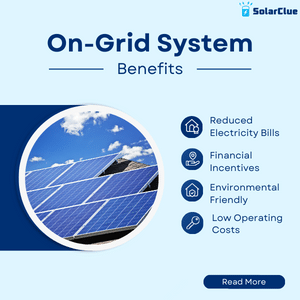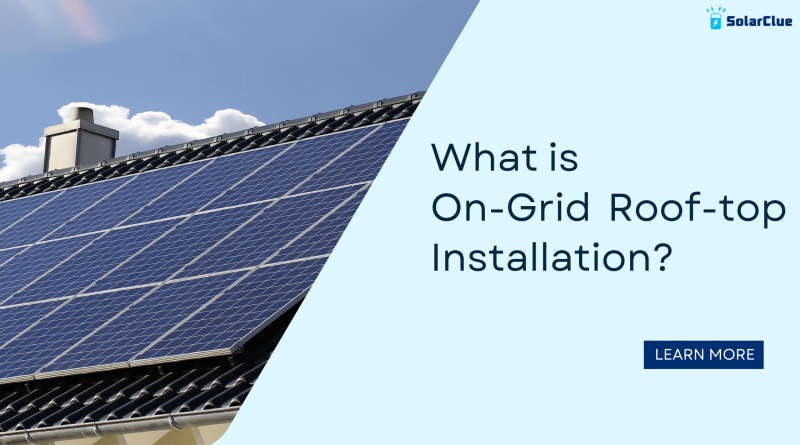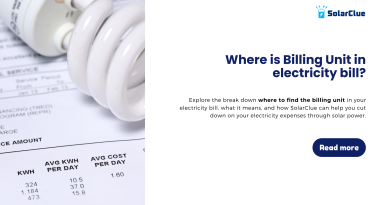What is On-Grid Rooftop Installation?
On-grid rooftop installation, a name itself saying that a installation of on-grid solar power system on top of the roof. It is a new way of generating solar energy that has grown in popularity in recent years. On-grid rooftop installation is growing as a cost-effective and environmentally responsible solution as individuals and organizations around the world seek ways to minimize their carbon footprint and lower their energy bills. This blog will cover what on-grid rooftop installation is, how it works, the benefits it provides, and how you can get started with this sustainable energy alternative.
Table of Contents
Understanding the On-Grid Rooftop Installation
Taking advantage of these incentives can drastically lower the upfront expenses for businesses and homeowners, making the initial investment in solar panel installation more reasonable.
What are the components used in On-Grid Rooftop Installation?
An on-grid solar installation, also known as a grid-tied or grid-connected system, is the process of connecting a solar generating system to the power grid. The following are the main components that are commonly used in an on-grid installation process:
- Solar Panels (Photovoltaic Modules)
- Inverter
- Mounting Structure
- Grid-Tie Inverter (GTI)
- DC Disconnect
- AC Disconnect
- Bi-Directional Meter
- Wiring and Cables
- Grounding Equipment
- Monitoring System
How Does On-Grid Rooftop Installation Works ?
A rooftop system on the grid requires several crucial parts to function as a unit. The solar panels themselves, often composed of photovoltaic (PV) cells converting sunlight into power, constitute the most important component. These panels install on the roof of a building at a location maximizing exposure to sunlight.
After the solar panels generate electricity, an inverter routes it. The inverter converts the direct current (DC) electricity produced by the solar panels into alternating current (AC) electricity, which can power household appliances or be fed into the grid. Additionally, the inverter synchronizes the produced electricity with the frequency and voltage of the grid.
A net meter is a necessary component of on-grid rooftop installation. It enables homeowners and businesses to calculate the amount of electricity they use from the grid as well as the amount of excess electricity they send back to the system. To precisely compute the power bill, the electricity provider offers a specific electricity meter that captures both incoming and outgoing electricity.
What are the Benefits You Get By Installing On-Grid Rooftop?
The following are the benefits you get by installing on-grid rooftop:

1. Reduced Electricity Bills
Generating your own electricity is possible with on-grid solar panels, reducing your reliance on the grid.
You can further decrease your electricity costs by sending back any excess power generated during the day, especially when there is plenty of sunshine, into the grid in the form of credits or repayment.
Using solar power to significantly reduce your monthly electricity costs provides long-term financial benefits.
2. Financial Incentives and Subsidies
Financial incentives, tax credits, or subsidies are provided by numerous areas and governments to promote the use of solar energy.
Businesses and homeowners can make the initial investment in solar panel installation more reasonable by taking advantage of these incentives, drastically lowering the upfront expenses.
By taking advantage of these financial incentives, you can reduce the payback period and increase the solar power system’s overall return on investment.
3. Environmentally Friendly
Solar power generates electricity without releasing any dangerous pollutants or greenhouse gases into the atmosphere, making it a clean and renewable energy source.
By utilizing solar energy, people and organizations can lessen their dependency on fossil fuels, promote environmental sustainability, and fight climate change.
Benefits to the environment include preserving natural resources and encouraging a better, cleaner Earth for present and future generations.
4. Low Operating Costs
When compared to other power sources, on-grid solar power systems often have lower operational costs.
Solar panels require little upkeep and don’t require fuel or continuous charges for the extraction and transportation of fuels.
Due to their extended lifespans, solar power system components like inverters and photovoltaic modules require fewer replacements over the course of the system’s lifetime, which lowers overall operating costs.
To sum up, the initial outlay for an on-grid rooftop solar system can lead to cheaper long-term operational costs, better financial incentives, lower electricity bills, and a good environmental impact. On-grid solar panels are a sustainable and appealing option for people and companies looking to utilize clean energy while reaping financial rewards because of these benefits.
How to Get On-Grid Rooftop Installation on Your Roof?
There are a few key steps you must take if you are considering on-grid rooftop installation. First, you should evaluate your rooftop’s solar potential. The efficiency of your solar panels can be affected by factors such as shading, orientation, and roof tilt. Consulting with a professional solar installer can assist you in determining the best placement and configuration for your particular situation.
Following that, you must calculate your energy consumption and determine the size of the solar panel system that you require. This will be determined by your energy requirements, available rooftop space, and budget. A solar installer can help you assess your energy needs and design a system that meets them.
Before the installation can happen, you must design your system and then get the required approvals and permits from the local authorities. To make sure that the procedure is completed safely and effectively, it is essential to collaborate with a reliable and knowledgeable solar installer.
Conclusion
Make a smart and sustainable choice for your energy needs—opt for rooftop solar panels with SolarClue® today! Choosing to harness solar energy through rooftop installations is not only economically savvy but also environmentally responsible. Businesses and homeowners alike can take control of their energy production, enjoying the dual benefits of reduced energy costs and a diminished carbon footprint. With rooftop solar panels seamlessly connected to the local grid, you contribute to a cleaner, greener future.
Embrace the on-grid rooftop installation option as a feasible and practical step towards sustainability. As renewable energy gains widespread recognition, make the decision to join the solar revolution now. SolarClue®, our trusted companion throughout the process, stands ready to guide you every step of the way. Experience the rewards of clean electricity production, lower energy costs, and a smaller environmental impact. Seize the opportunity to live in an environmentally friendly future—choose rooftop installation connected to the grid with SolarClue® leading the charge. Act now, and let SolarClue® be your partner in building a brighter, more sustainable tomorrow.
Frequently Asked Questions
On-Grid Rooftop Installation involves placing solar panels on a building’s roof, connected to the local power grid for efficient energy management.
Solar panels convert sunlight into electricity, powering the building. Excess energy is sent to the grid, and users draw power from the grid when solar production is insufficient.
Lower electricity costs, the ability to sell surplus energy, a consistent power supply during low solar production, and potential eligibility for government incentives.
While not mandatory, adding battery storage allows for storing excess energy, providing backup during power outages or when grid electricity prices are high.
Installation times vary but typically range from a few days to a couple of weeks, depending on the system size and complexity.
Yes, the grid connection ensures a continuous power supply even during solar production lulls or power outages.
Yes, but bills are significantly reduced as you consume the energy generated by your solar panels and sell excess power back to the grid.
Routine inspections are advisable, but solar panels generally require minimal maintenance. Cleaning may be needed periodically for optimal performance.
Most systems come with monitoring tools, allowing users to track energy production and consumption in real-time through a user-friendly interface.
Yes, many systems are scalable, allowing for additional solar panels to be added to meet increased energy needs over time.


